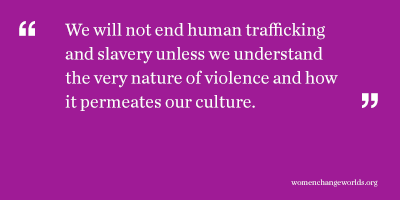
New York Times columnist and anti-trafficking advocate Nicholas Kristof recently opened January’s Human Trafficking Awareness month with a Google+ Hangout entitled, “What does 2014 hold for the fight against modern-day slavery?” My answer is the need to dispel myths about sexual violence against women and children within the anti-trafficking movement so that we can all work effectively and sustainably toward ending exploitation. I hold little hope for truly ending human trafficking unless we understand the systemic nature of violence against women and children.
I strongly believe human trafficking and sexual slavery are a manifestation and continuation of interpersonal and systemic violence. For instance, the top two risk factors for sexual exploitation are a history of child sexual abuse and poverty. Yet, International Justice Mission founder and President Gary Haugen argued that an environment of impunity, not violence, is to blame:
[S]lavery is first and foremost a violent crime…and if you were to look at any other crime that would take place in our community that’s violent – let’s say rape – we would of course want to change those attitudes. We would of course want to make sure that the streets were well lit. We would want to make sure that women knew how to walk safely and avoid dangerous areas. But you would start, absolutely, that people who committed sexual assaults actually went to jail for it. You are more likely to get struck by lightning than go to jail for committing that violent crime.
 Utilizing such “rape myths” like the need for well-lit streets and women’s ability to walk safely perfectly illustrates Haugen’s limited understanding of sexual violence: the majority of sexual assault survivors know their assailants and most rapes occur at home.
Utilizing such “rape myths” like the need for well-lit streets and women’s ability to walk safely perfectly illustrates Haugen’s limited understanding of sexual violence: the majority of sexual assault survivors know their assailants and most rapes occur at home.
“Law enforcement is absolutely a critical component,” said Rachel Lloyd, trafficking survivor and founder of Girls Educational & Mentoring Services (GEMS), “but it isn’t the only component…and it won’t be the thing that long-term changes the issue.”
We will not end human trafficking and slavery unless we understand the very nature of violence and how it permeates our culture. Among industrialized nations, the U.S. has the worst record of death from violence and child death from abuse and neglect. We have the second-highest incidence of child poverty. Estimates across various surveys suggest one in every four girls and one in four boys in this country are sexually abused, 90 percent of them by either a family member or someone they know and trust. We have created the “perfect storm” for trafficking.
We also must acknowledge how violence is perpetuated. We often overlook that most of the few exploiters who have been studied report a history of child sexual abuse. Men who buy sex also report histories of sexual abuse and describe themselves as “sex addicts.” Abused children can repeat the violation throughout their lives, often within gendered norms, according to trauma expert Bssel van der Kolk, M.D. Abused boys can re-victimize, thus fulfilling the masculine imperative of being dominant and in control, while abused girls can go on to form relational attachments with victimizing boys or men.
If we are to stop human trafficking we must prioritize healing the wounds of abused boys through comprehensive, trauma-informed care over jailing angry, isolated men who become traffickers. We must focus on ensuring abused girls have economic opportunity based on intellect rather than equating their worth with their bodies. I am not arguing we sympathize with offenders because they have been abused. However, I am saying that jailing exploiters and solicitors will not stop trafficking: cycles of child sexual abuse and poverty are the fuel that keeps the engine running. We need to empty the gas line.
Kate Price, M.A., project associate at the Jean Baker Miller Training Institute (JBMTI) at the Wellesley Centers for Women (WCW), is also a social scientist in the cultural construction of childhood. As a survivor of the commercial sexual exploitation of children (CSEC), Price authored a chapter in the textbook, Global Perspectives on Prostitution and Sex Trafficking: Europe, Latin America, North America, and Global (Lexington Books) and a JBMTI working paper, Longing to Belong: Relational Risks and Resilience of Commercially Sexually Exploited Children, examining CSEC through a Relational-Cultural Theory lens.
When you subscribe to the blog, we will send you an e-mail when there are new updates on the site so you wouldn't miss them.
Comments